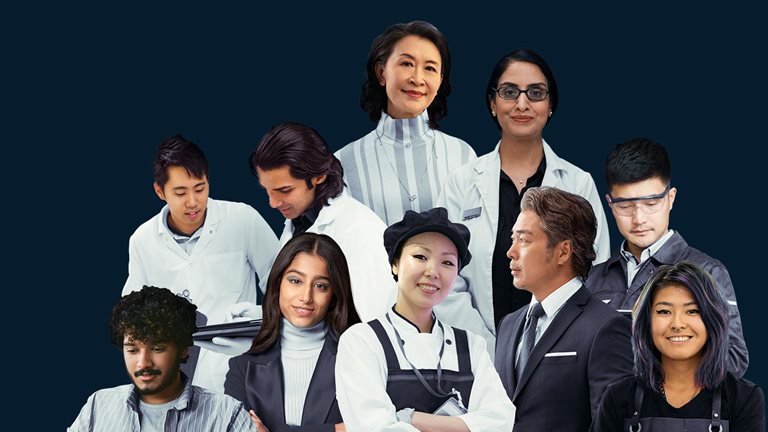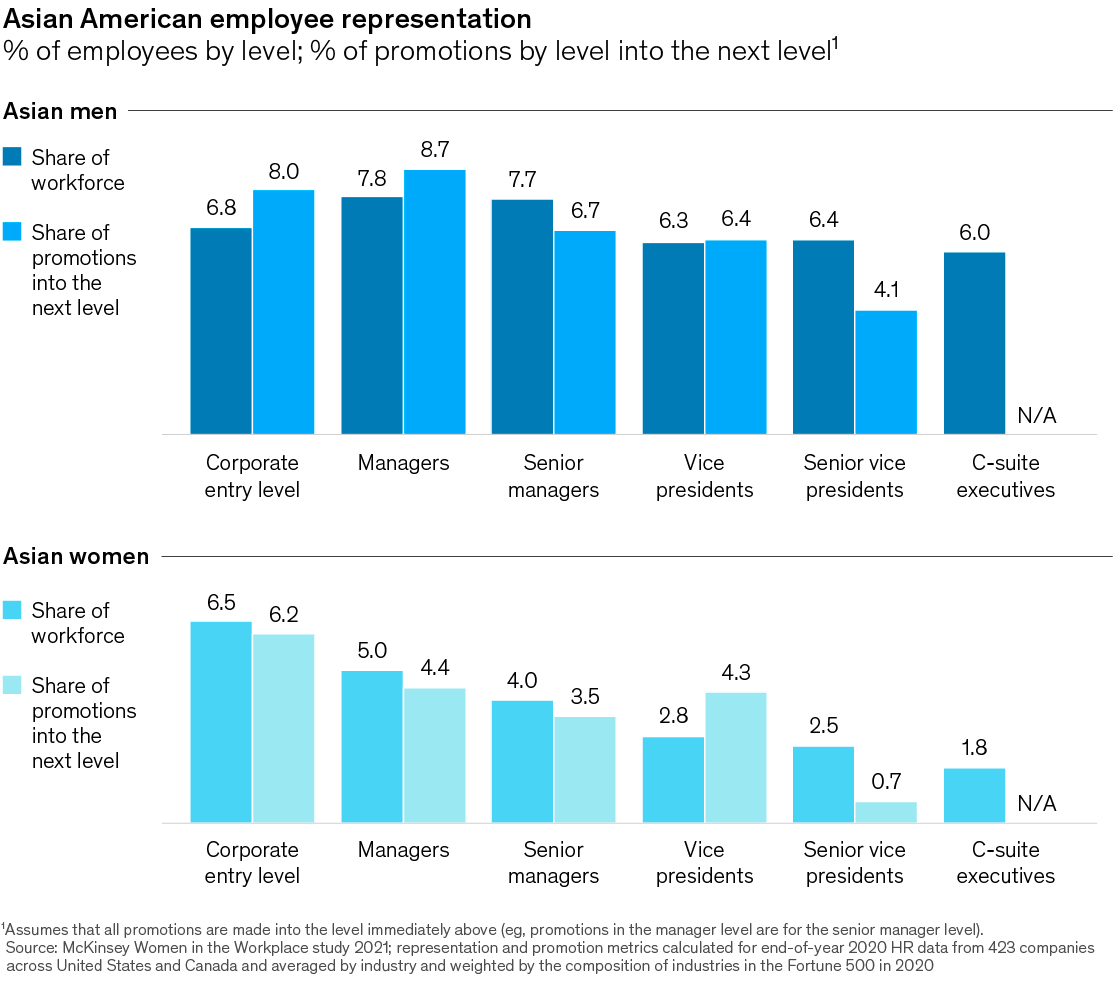| | |
 |
Edited by Justine Jablonska
(she/her/hers)
Editor, New York |
|
|
|
|
| |
|
Insights and strategies to nurture diversity, equity, and inclusion in the workplace. In your mailbox every two weeks.
|
|
|
Asian Americans are a rapidly growing segment of the workforce—and one that is subject to pervasive and potentially harmful myths. In this issue, we explore McKinsey’s first-of-its-kind report on Asian Americans in the workplace, which counters these misconceptions. We also examine how leaders can better support advancement and inclusion for Asian American workers. Plus, a new approach to attracting and retaining talent as the Great Attrition continues, and our take on one reader’s question about how to introduce diversity, equity, and inclusion into the workplace.
|
|
|
| |
| | |
Asian Americans comprise about 6 percent of the US population; they are a nearly 20-million-strong group, with immense diversity. In a new report, Asian American workers: Diverse outcomes and hidden challenges, McKinsey partner Michael Chui, senior partner Kweilin Ellingrud, and partner Ishanaa Rambachan examine this group’s wide-ranging distribution across roles and industries. Asian Americans are overrepresented in higher-wage technical fields, the report finds—and overrepresented in low-wage jobs such as cooks and skin care specialists. As a race, Asian Americans have the highest income inequality in the US, which translates to vastly different economic outcomes. Often regarded as a “model minority”—a stereotype highlighting the group’s perceived success—Asian Americans tend to sputter up the career ladder, even in industries and roles where they have high levels of representation. “Our goal is to spark an expansive, ongoing conversation about better inclusion and advancement for Asian Americans at work,” say the report’s authors. That goal is especially urgent given the increased violence against Asian Americans in recent years, with one in six Asian Americans reporting that they’ve experienced a hate crime or hate incident in 2021.
|
|
|
| |
| | |
We recently sat down with Kewilin Ellingrud, McKinsey Global Institute director, senior partner, and coauthor of the new report Asian American workers: Diverse outcomes and hidden challenges, to learn more about her latest research.
1. What is your biggest takeaway from this report?
It’s how varied the outcomes are across Asian American communities. There’s this notion that Asian Americans are a model minority that is doing very well both in relation to Whites and other underrepresented groups. And while that’s true in pockets, our research revealed enormous variability in educational outcomes and income, including a surprising number of Asian Americans in poverty. Asian Americans come from countries that make up more than half the population of the world, and they are a rapidly growing part of the US population. Employers need to figure out how to best use this incredible source of talent in their workplaces.
2. Did anything in the results surprise you?
The most surprising piece to me was that Asian Americans still have substantial gaps in the workplace. Even before they enter the workforce, Asian Americans are overachieving and earning a higher level of education degrees, which should translate into work progression but doesn’t. And even while they’re overrepresented in higher-paying professions—but also overrepresented in lower-paid professions—there’s a significant wage gap compared with White peers even in the higher-paying occupations. Asian Americans are, even in higher-paying professions, earning 93 cents on the dollar compared with their White peers.
And Asian Americans in those professions are not advancing as much in the talent pipeline as their White peers. Asian Americans are fairly well represented from the entry level up through even senior vice president. But there’s a dramatic drop-off in the C-suite, which also means that far fewer Asian Americans report to a CEO. Asian Americans account for only 8 percent of C-suite executives, and Asian American women account for just 2 percent. So in terms of intersectionality, if you’re a woman and a minority, it’s doubly hard, and we’re certainly seeing that play out for Asian American women and their slower career progression.
3. Are there any findings that particularly resonated with you?
I was also struck with our findings that Asian Americans are less likely to feel sponsored, to feel that they can be their authentic selves at work. And especially recently, with a huge rise in Asian American hate crimes, they’re more likely to feel not welcome.
Our data also shows that Asian Americans are less likely to have sponsors at work; part of that may be due to a lack of comfort in asking for something for yourself, and, as surfaced in our interviews for the report, a feeling of, “This doesn’t quite feel right according to how I was raised.” Understanding these types of barriers is critical in equalizing the playing field. As we found in our report, for Asian Americans, even if you’re equally educated and skilled, you’re less likely to have the sponsorship to tell you the unwritten rules, to help you get ahead and get that next opportunity. |
|
| |
| |
|
|
MAKE IT RIGHT: WHAT CAN LEADERS DO? |
|
|
Senior partner Kweilin Ellingrud: First, understand your company’s data better. You can’t take the majority of the world’s population and lump it into one group without the granularity of understanding that an immigrant from Burma is very different from an IT leader from India, who is very different from a third-generation Chinese American—all very different populations with different needs.
Just as important is widening the aperture on the perception of leadership. Leadership does not have to be just tall, White, and male. The definition of what it means to be a leader should be much broader.
Finally, it’s having awareness that some aspects of American corporate culture may be countercultural for those who were raised in a traditionally Asian way; there are equivalents in many other cultures as well. I’ve had to unlearn some behaviors in order to be more mainstream and accepted in the workplace and to move ahead. That includes getting more comfortable with talking about myself, speaking confidently about what I can do, disagreeing with those who may be older and more experienced than I am—these are all skills that are important in some workplaces. I would encourage leaders and organizations to be mindful of that. |
|
| |
| |
| |
|
As the Great Attrition continues, it’s more important than ever that leaders understand what makes their employees tick. Tune in to a recent episode of The McKinsey Podcast to learn about five employee personas that companies can reach in their search for talent (and also figure out which one you are!). As the authors of “‘Great Attrition’ or ‘Great Attraction’? The choice is yours” note, the business-as-usual approach of finding and keeping employees simply isn’t working anymore. |
|
| |
| |
| |
|
One of our readers asks: ‘How can I effectively introduce DEI into my workplace?’
Thank you for taking the time to write in! Our research has shown that many employees want their organizations to do more to advance diversity, equity, and inclusion (DEI) in the workplace. But where to start? Each workplace is unique and comes with its own specific challenges—and opportunities. Four key factors, along with plenty of data, can help employers and employees understand the benefits of DEI in the workplace. Next, organizations can take three steps to supercharge DEI capability building, which can help to create thoughtfully designed DEI programs around the behaviors and moments that matter most. And as companies work to design and deliver DEI programs, leaders should be aware of three common pitfalls to avoid. Also, check out our collection of blog posts on why inclusion matters and how to foster it: the information here ranges from the educational to the practical, including a case study of how one company used hard data to develop an actionable road map for its ongoing DEI journey. |
|
| |
| |
|
| |
| | | |
This email contains information about McKinsey's research, insights, services, or events. By opening our emails or clicking on links, you agree to our use of cookies and web tracking technology. For more information on how we use and protect your information, please review our privacy policy. |
|
You received this email because you subscribed to the Intersection newsletter. |
|
|
Copyright © 2022 | McKinsey & Company, 3 World Trade Center, 175 Greenwich Street, New York, NY 10007 |
|
|
|
|
|





